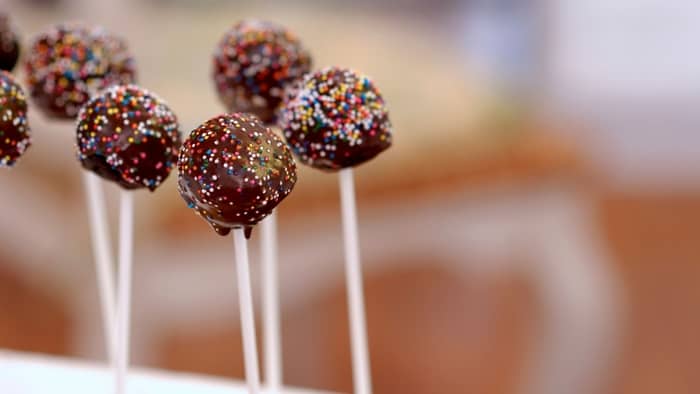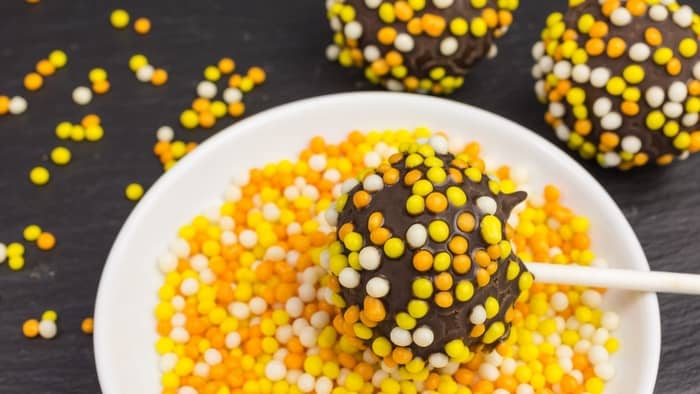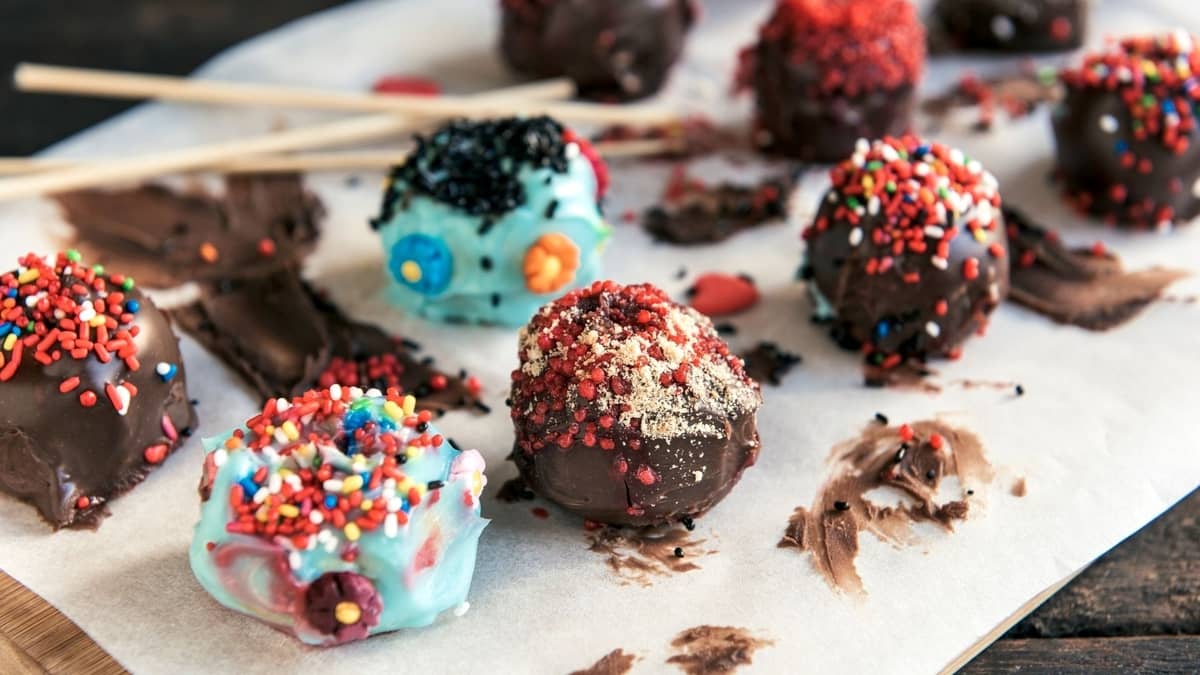Last Updated on February 15, 2023
Are you new to the art of making cake pops and wondering why are my cake pops cracking? We have the answers for you and ways to prevent and fix it.
These treats are surprisingly delicate and with one wrong move, they’re cracked! Luckily, we have created an in-depth article to explain precisely how cake pops are made, why and how they crack, and ways to prevent it. And, if all else fails, we’ve also included some easy ways to fix any crack.
What Are Cake Pops?
Cake pops are types of confections that resemble lollipops. But, instead of hard candy, they are made using balls of cake that are coated with melted chocolate or a similar type of glaze.
The trick to making cake pops lies in the type of cake and glaze you use.

When it comes to the cake part, it is important to use a cake that isn’t too moist but can be molded. Dry cake works well because they form better and create denser balls and the stick onto which they are attached doesn’t slip out as easily.
When making cake pops, the cake or cake crumbs are mixed well with some frosting to make them stick and form a smooth ball.
Once the balls have been shaped, sticks inserted, and the cake pop allowed to solidify, it gets dipped into some melted chocolate to form a hard shell.
While the chocolate is still wet, garnishes can be added that will stick to it. These garnishes can include anything from sprinkles, sugar crystals, gold leaf, rose petals, chopped nuts, and seeds.
Why Are My Cake Pops Cracking?
While these balls sound incredibly simple to make but trust us, there is a lot that can go wrong. One of the most frustrating and common issues with making these treats is that they crack. So, let’s look at some of the most common reasons for cracking.
The temperature difference between cake and chocolate
1. Too Hot
This is by far the most common reason that cake pops crack. The temperature of the actual cake pop was probably too cold and the temperature of the melted chocolate was too hot. It is also possible that the cake pop was too hot for the cold melted chocolate.
So, how this works is as follows. When making the cake pop ball, it should be set. Sometimes, people set it in the fridge so that the frosting dries out and creates a hardball. When the ball is chilled, naturally, it shrinks a little.
Then, the chilled cake pop ball is dipped into warm chocolate. The chocolate starts setting while the cakes’ temperature comes back to room temperature.
So, as the cake heats back up, it expands, which then cracks the set chocolate.
2. Too Cold
Even if your chocolate has had time to cool and isn’t too hot, your cake pops can still crack if your cake is too cold. If you leave your cake pops in the freezer for over 15 minutes, they may become too cold which can lead to cracking. While it is beneficial to have chilled cake pops before dipping them in chocolate, be sure not to leave them in the fridge or freezer for too long.
How to Prevent Cake Pops From Cracking
Now that we have explained exactly why cake pops tend to crack, it is kind of easy to understand how to prevent cake pops from cracking. The simple solution is to get the two components to have similar temperatures.
Now, setting cake pops inside the fridge is an essential step in the process and cannot be skipped or cheated.
So, you must bring the cake pop balls back to room temperature, or at least close to it.
Then, it is also important to make sure that the chocolate isn’t extremely hot. The melted chocolate should be cooled back to room temperature. This will not only help it set quicker but also help it adhere to the cake much better and create a smooth even coating.
So, when the cake is now coated with chocolate, it has already expanded and the set chocolate won’t crack anymore.
A fantastic tip is to use any type of thermometer (preferably digital) that has a needle tip. This handy tool will help you gauge the temperature of the cake pop and the melted chocolate.
Word to the wise – Why are my cake pops cracking?
When trying the above-mentioned technique to prevent cake pops from cracking, you will still have to do some experimenting. This is why we highly recommend using a thermometer to make notes on the temperature of the cake and the chocolate.
This way you can precisely see which temperatures work for your specific recipe.
Why Are My Cake Pops Cracking? How to Fix Cracked Cake Pops
Unfortunately, there aren’t a ton of options you can use to “fix” cracked cake pops. If you don’t mind the crack, you can simply leave it as-is. We promise they will still be as delicious as without them!
Otherwise, you basically only have two or three options to choose from. The first is to use a small pallet knife and fill up the crack with more melted chocolate. The added chocolate will also eventually set and fill the crack. However, it will still be very noticeable.

The second option is to re-coat the entire cake pop. This will give you a smoother finish, especially when the crack was small. For bigger cracks, the new chocolate will settle in the crack and cause an uneven coating. But, it is definitely the best option to completely remove a crack from a cake pop.
The third and final option you have is to cover the crack with other garnishes. Again, the type of garnish you use will depend on the size of the crack you have.
If you have small cracks, you can try covering them with edible gold leaf or flower petals. These will give the cake pops a very elegant and sophisticated look. Alternatively, you can dip the top in more melted chocolate before adding sprinkles, chopped nuts, or candy pieces.
Why Are My Cake Pops Cracking When Rolling?
If your cake pops are cracking as you are rolling them, this is likely because they do not have enough moisture. A lack of moisture means that they will be dry and crumbly and won’t be able to stay together.
To help solve this problem, you will want to add more frosting to your cake ball mix. Start by adding one tablespoon more and then add more frosting if need be until you reach your desired consistency. The frosting will add moisture to your cake pops and help them to stick together when rolling and lessen your chances of cracking.
Cake pops should have a doughy, fudgy consistency. They should not have the same consistency as cake as they will not be able to stay in balls without the addition of frosting or cream cheese.
Why Do My Cake Pops Fall Off The Stick?
One of the most common problems with cake pops is the cake pop falling off the stick. Even bakers with years of experience under their belt have likely faced this problem before when making cake pops.
One of the most common reasons cake pops fall off their sticks is because they are too large. While it can be tempting to make cake pops large, the lollipop stick will not be able to support them if they are too big. You generally don’t want to make your cake pops larger than three tablespoons per cake pop.
Another reason cake pops fall off of their sticks is from moving the lollipop sticks too much when dipping your cake pops in chocolate. Too much movement can loosen the cake pops from the sticks, resulting in them falling off.
In addition, your cake pops may be falling off if the cake isn’t moist enough. Without enough moisture, the cake pops will become dry and crumbly and won’t be able to stay on the lollipop stick. Be sure to use enough frosting or cream cheese in your cake pops so it becomes pliable.
To help prevent your cake pops from falling off, dip the tip of the stick in chocolate before adding your cake ball. Once you add your cake pop to the lollipop stick, allow it to sit for a few minutes before dipping it in the melted chocolate to coat the whole cake pop. The chocolate will work like glue to help hold the cake pop to the stick.
The Proper Cake Pop Consistency
Getting the proper cake pop consistency is key to a tasty and attractive cake pop. Cake pops should have a consistency that is doughy, fudgy, and easy to form a ball. You can use frosting or cream cheese to achieve the proper consistency for your cake pops.
If the cake pops can’t hold together when you roll them into a ball and are crumbling, then you need to add more frosting. If your cake pops are too soft to hold their shape on the stick and are very soft, then you added too much frosting.
20 Cavity Silicone Cake Pop Mold Kit
Final Thoughts – Why Are My Cake Pops Cracking?
As you can see, the answer to “Why are my cake pops cracking?” is fairly simple once you completely understand how they work. And so, it is also very easy to comprehend how to prevent the problem entirely. We hope that our amazing tips and tricks helped you prevent cracks in your cake pops and that you could find a way to fix it too.
Read more about What To Do With Failed Brownies?
FAQs
How do I stop my cake pops from cracking?
The bets way to entirely prevent the cake pops from cracking is to make sure the cake and frosting or melted chocolate have similar temperatures. This way the chocolate won't crack as the cake heats up and expands.
Should I freeze my cake pops before dipping?
Many people freeze cake pops before dipping them to help set the stick in place. However, the trick is to remove it after 15 minutes (at the most). This will cool the cake pop, but not make it so cold that the chocolate will crack when exposed to the sudden temperature difference.
Why are my cake pops cracking and leaking oil?
When a cake pop leaks oil, it is usually because the cake is very wet or extremely dense. This is caused by a high ratio of eggs and oil. other reason for oil leaking from your cracked cake pops is because the ball contains too much frosting compared to cake. As the cake ball heats up, the oil separated from the mixture and leaks.

Lindy Van Schalkwyk is a culinary specialist with a background in Advanced Cooking, Advanced Pâtisserie, Media Communications and Nutrition. She has gained invaluable experience in the culinary industry having worked in some of the top restaurants in Africa in 2016 and 2017. Her expertise in nutrition has enabled her to develop recipes for special dietary needs. In 2018, Lindy began working in the Food Media industry, focusing on recipe development, recipe writing, food writing and food styling.


